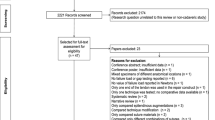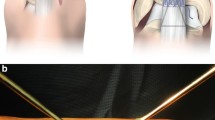Abstract
Purpose
The study aim was to describe what kind of operative technique performs best with respect to initial strength after the surgical repair of acute Achilles tendon ruptures.
Methods
We performed a systematic search of the keywords “Achilles tendon AND (suture strength OR biomechanics) AND (cadaver NOT animal)” in the online databases PubMed, EMBASE, CINAHL, and the Cochrane Library. We included studies that employed open, mini-open, or percutaneous Achilles tendon repair in human cadavers, and assessed some measure of tensile strength as a primary outcome.
Results
Our search produced 11 relevant papers reporting results for Kessler, Bunnell, and Krackow sutures in open repair, as well as the Achillon device, the Ma-Griffith repair technique, the triple bundle technique and the “giftbox” technique. The weighted tensile strengths ranged from 81 to 453 N (mean 222.7 N) with the Triple Bundle technique in combination with # 2 Ethibond performing best with a mean of 453 N.
Conclusions
Due to the small sample sizes, different study designs, and heterogeneity of strength measurement techniques, definite recommendations on surgical technique cannot be made but presented information might help in the decision making process for foot and ankle surgeons.

Similar content being viewed by others
References
Maffulli N (1999) Rupture of the Achilles tendon. J Bone Joint Surg Am 81:1019–1036
Mafulli N, Waterson SW, Squair J, Reaper J, Douglas AS (1999) Changing incidence of Achilles tendon rupture in Scotland: a 15-year study. Clin J Sport Med 9(3):157–160
Bhattacharyya M, Gerber B (2009) Mini-invasive surgical repair of the Achilles tendon-does it reduce post-operative morbidity? Int Orthop 33(1):151–156
Chiara Vuliani M, Guzzini M, Ferreti A (2003) Operative treatment of chronic Achilles tendinopathy. Int Orthop 27(5):307–310
Maffulli N (1999) Rupture of the Achilles tendon. J Bone Joint Surg Am 817:1019–1036
Assal M, Jung M, Stern R et al (2002) Limited open repair of Achilles tendon ruptures: a technique with a new instrument and findings of a prospective multicenter study. J Bone Joint Surg Am 84:161–170
Buchgraber A, Pässler HH (1997) Percutaneus repair of Achilles tendon rupture: immobilization versus functional postoperative treatment. Clin Orthop 341:113–122
Cetti R, Christensen SE, Ejsted R et al (1993) Operative versus nonoperative treatment of Achilles tendon rupture. A prospective randomized study and review of the literature. Am J Sports Med 21:791–799
Möller M, Movin T, Granhed H et al (2001) Acute rupture of tendo Achillis. A prospective, randomized study of comparison between surgical and non-surgical treatment. J Bone Joint Surg Br 83:843–848
Kocher MS, Bishop J, Marshall R, Briggs KK, Hawkins RJ (2002) Operative versus nonoperative management of acute Achilles tendon rupture: expected-value decision analysis. Am J Sports Med 306:783–790
Wills C, Washburn S, Caiozzo V, Prietto CA (1986) Achilles tendon rupture: a review of the literature comparing surgical versus nonsurgical treatment. Clin Orthop Relat Res 207:156–163
Crolla RMPH, van Leeuwen DM, van Ramshorst B et al (1987) Acute rupture of the tendo calcaneus. Surgical repair with functional after treatment. Acta Orthop Belg 53:492–494
Moher D, Liberati A, Tetzlaff J, Altman DG, Group P (2009) Preferred reporting items for systematic reviews and meta-analyses: the PRISMA statement. BMJ 339:b2535
Moher D, Cook DJ, Eastwood S, Olkin I, Rennie D, Stroup DF (1999) Improving the quality of reports of meta-analyses of randomised controlled trials: the QUOROM statement. Quality of reporting of meta-analyses. Lancet 354(9193):1896–900
Cook KD, Clark G, Lui E et al (2010) Strength of braided polyblend polyethylene sutures versus braided polyester sutures in Achilles tendon repair: a cadaveric study. J Am Podiatr Med Assoc 100:185–188
Cretnik A, Zlajpah L, Smrkolj V, Kosanovic M (2000) The strength of percutaneous methods of repair of the Achilles tendon: a biomechanical study. Med Sci Sports Exerc 32:16–20
Gebauer M, Beil FT, Beckmann J et al (2007) Mechanical evaluation of different techniques for Achilles tendon repair. Arch Orthop Trauma Surg 127:795–799
Herbort M, Haber A, Zantop T et al (2008) Biomechanical comparison of the primary stability of suturing Achilles tendon rupture: a cadaver study of Bunnell and Kessler techniques under cyclic loading conditions. Arch Orthop Trauma Surg 128:1273–1277
Huffard B, O'Loughlin PF, Wright T et al (2008) Achilles tendon repair: Achillon system vs. Krackow suture: an anatomic in vitro biomechanical study. Clin Biomech (Bristol, Avon) 23:1158–1164
Jaakkola JI, Hutton WC, Beskin JL, Lee GP (2000) Achilles tendon rupture repair: biomechanical comparison of the triple bundle technique versus the Krakow locking loop technique. Foot Ankle Int 21:14–17
Labib SA, Rolf R, Dacus R, Hutton WC (2009) The "Giftbox" repair of the Achilles tendon: a modification of the Krackow technique. Foot Ankle Int 30:410–414
Lee SJ, Goldsmith S, Nicholas SJ et al (2008) Optimizing Achilles tendon repair: effect of epitendinous suture augmentation on the strength of achilles tendon repairs. Foot Ankle Int 29:427–432
McCoy BW, Haddad SL (2010) The strength of Achilles tendon repair: a comparison of three suture techniques in human cadaver tendons. Foot Ankle Int 31:701–705
Shepard ME, Lindsey DP, Chou LB (2007) Biomechanical testing of epitenon suture strength in Achilles tendon repairs. Foot Ankle Int 28:1074–1077
Zandbergen RA, de Boer SF, Swierstra BA et al (2005) Surgical treatment of achilles tendon rupture: examination of strength of 3 types of suture techniques in a cadaver model. Acta Orthop 76:408–411
Author information
Authors and Affiliations
Corresponding author
Rights and permissions
About this article
Cite this article
Sadoghi, P., Rosso, C., Valderrabano, V. et al. Initial Achilles tendon repair strength—synthesized biomechanical data from 196 cadaver repairs. International Orthopaedics (SICOT) 36, 1947–1951 (2012). https://doi.org/10.1007/s00264-012-1533-6
Received:
Accepted:
Published:
Issue Date:
DOI: https://doi.org/10.1007/s00264-012-1533-6




